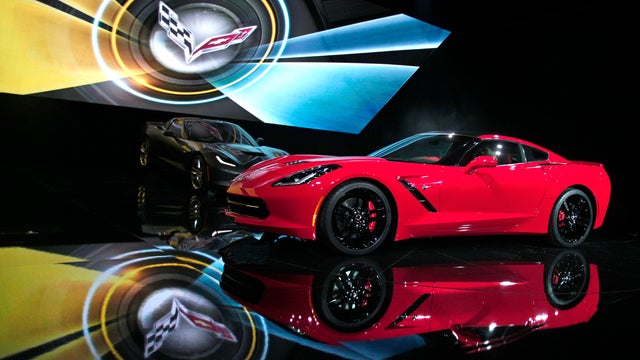The Corvette: An American classic renewed
(CBS News) The Chevrolet Corvette turned 60 years old this past week. The iconic American sports car has been through a lot over those years. But now there's a NEW "Little Red Corvette" on the block. Our Lee Cowan takes us for a spin:
When Alan Shepard blasted off from Cape Canaveral in 1961, he left behind his other rocket ship -- a Chevy Corvette.
He owned a few of them over the years -- several astronauts did, in fact -- images that forever linked the Corvette to real adrenaline junkies.
But it was 1963, when the Corvette turned into something truly special: The newly-unveiled Stingray, "a car worthy of its sports car designation," the ads said.
It became an instant classic - still is today.
And now a half-century later, Chevy is taking a bold leap, bringing the hallowed Stingray back.
General Motors is hoping the new Stingray will put America's oldest auto nameplate back in the winner's circle. Unleashed in Detroit last week, it's lower, wider, and faster - and it's got an attitude.
"It's like a fire-breathing monster, it looks like it," said Jean Jennings, As editor of Automobile Magazine, she has seen Corvettes come and go. But this time, Jennings says, GM is sending a message.
"It still has the wherewithal to make a dream car, a two-seat sports car that costs a lot of money and delivers a huge whack of fun!" she told Cowan.
"What else is it? It's a two-seat car with a giant motor right between your legs. Baah! I'm outta there!"
Its V8 cranks out 450 horsepower. But it's hardly a gas guzzler. It can shut down half its cylinders off for better fuel economy.
And the interior now looks and feels, much more like its European competitors.
"Pretty much anything that you can hear feel or touch, you can pretty much customize it all, said Tadge Juechter, the Corvette's chief engineer. This is his baby. It's the only one, and Cowan was the first outside person to sit in it.
So he was understandably a little nervous about taking us on its first ride.
It'll do zero to 60 in less than four seconds. Top Speed? Upward of 190 miles an hour.
"There's no doubt in my mind that we'll be fully competitive with pretty much any other car," said Juechter.
Porsche? Ferrari? "You name it!" Juechter said with a laugh.
When asked how he would describe the new 'Vette in one word, Tom Peters, the head of Corvette design., replied, "Wow!"
He's in charge of sculpting the body to make it fast and functional. Just one little curve, he told Cowan, "probably might have taken as much creative energy as doing a whole body side. "
Not all Corvette purists, though, like the re-design.
Some mourn the loss of the signature round tail lights. Others worry it looks too much like a Dodge Viper.
But America's sports car has rarely had an easy ride.
It was first unveiled at GM's Motorama in 1953. For $3,500 -- double the price of other Chevys at the time -- you could take one home. But that early Vette was more "show" than "go," says automotive historian Paul Ingrassia.
He told Cowan, "It wasn't very fast. Wasn't very stable. Oh, and the roof leaked too, by the way!"
That Corvette idea though, had a champion: its legendary chief engineer, Zora Duntov. He persuaded Chevy to replace its standard inline six with a V-8 instead, and the Corvette was soon tearing up the track.
"Over the years he actually added you know, suspension, transmission, steering, that really made it a real, legitimate sports car instead of a fashion statement," said Ingrassia.
By the '60s, the Corvette was a celebrity -- starring in its own TV show, "Route 66."
And the Stingray even had a song: "Dead Man's Curve," by Jan and Dean.
But then came the '70s, and along with them unleaded fuel, the oil crisis, and the national 55 mile an hour speed limit.
By the '80s, sales were stuck in low gear -- and the Corvette seemed to symbolize more mid-life crisis than icon.
"It was a slot car on the race track, and on the road it was a farm implement!" laughed Automobile Magazine's Jennings. "You know, it had terrible suspension, you literally drove it, hit a pothole and banged your head on the head liner!"
Still, the Corvette survived, even through GM's bankruptcy.
"It would be such a shame for that car to be missing in the America's culture," said Chevy dealer Rick Hendrick. "I mean, I just think it's part of the DNA of Chevrolet."
Hendrick should know. He also owns Hendrick Motor Sports, one of the winningest teams in NASCAR.
Would he race anything else, besides a Chevy? "Never have," he laughed."
His passion for Chevy, has turned into, well, almost hoarding. He owns one of the largest private Corvette collections in the world -- nearly 150 in all.
His favorite was always the Stingray -- and he's more than willing to share the love.
What was it about Corvette for him? "The Corvette was just the ultimate car," Hendrick said. "I mean, it was you had the styling, the power, all the girls liked 'em."
In fact, it was in a Stingray where he wooed his future wife, Linda. "She rode with me in that first Corvette on our first date and it broke down," he laughed. "She wasn't very impressed."
Most of what is in his collection is priceless. Last night Hendrick purchased the rights to get the very first new Stingray off the line.
"I think this car will probably be one of the most sought after cars that we've seen in a long time," Hendrick said.
Will the new Stingray live up to its pop culture royalty?
That's between you, the wheel, and the open road....

